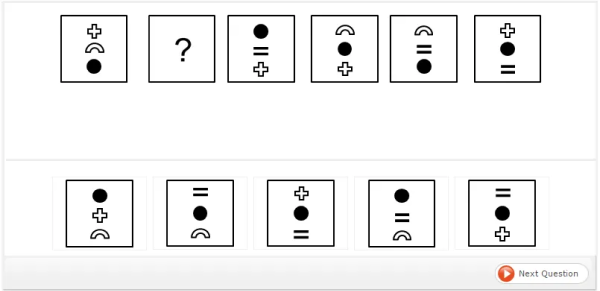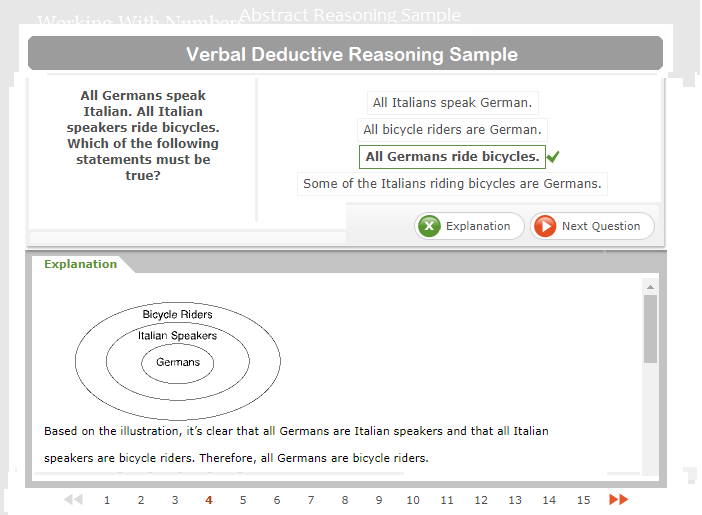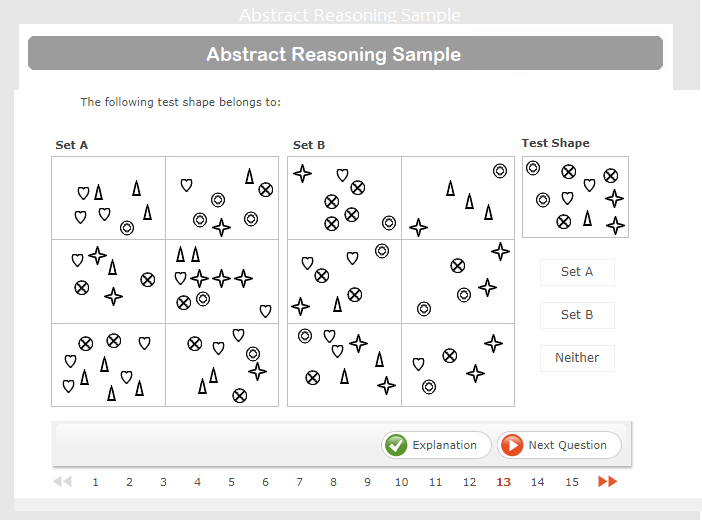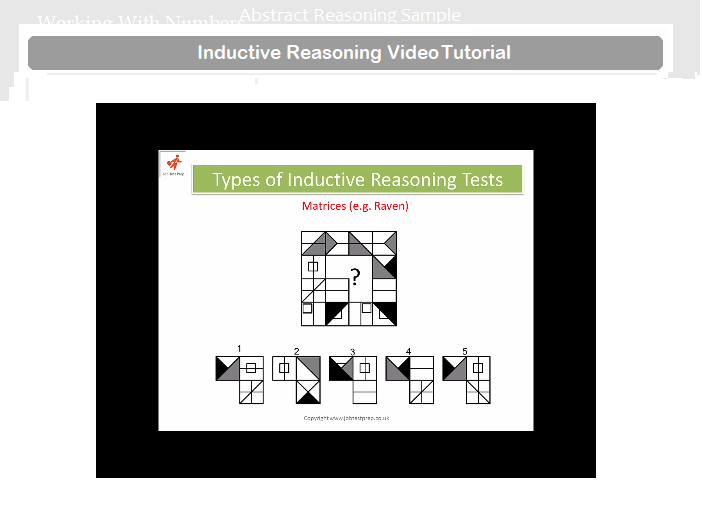What You'll Get
- 25 inductive reasoning tests
- 13 deductive reasoning tests
- 9 abstract reasoning tests
- Matrices and number series tests
- Score reports and comprehensive solving tips
- Inductive reasoning study guide and video tutorial
About
Logical reasoning tests (in the sense of employers' online aptitude tests) usually consist of abstract, diagrammatic or inductive reasoning tests. Employers often use these tests as part of their online selection process.
It would be easier to describe logical tests as non-verbal reasoning tests, since they do not present you with verbal or numerical information but instead with shape sequences and the logical patterns that they represent.
Here are a few links to information about logical reasoning tests published by the leading assessment companies:
- Talent Q logical reasoning
- Saville abstract reasoning
- SHL logical reasoning
- Kenexa logical reasoning
- cut-e abstract logical ability
It's important to note that the term "logical reasoning" is also used to describe verbal logical reasoning tests.
These are used in many undergraduate and graduate admissions tests and in certain selection processes. Scroll down to see some verbal logical reasoning questions.
Are you about to take the UCAT? Take a free practice test.
Are you about to take an SHL Assessment? Practice with a free SHL test.
Are you invited to take an AON Cut-e test? Try our free Cut-e test
Verbal Logical Reasoning Sample Questions
Here are four examples of verbal logical reasoning questions. Choose the correct answer for each question:
(1) Choose the image that completes the pattern.

Answer:

Each square contains 3 shapes. The black circle is the only shape that constantly appears. It “travels” along the column up and down, one step at a time. The other shapes appear in two consecutive squares and then, do not appear in the next square. The shape that remains in the frame (in regards to the last step from the left) maintains its relative position to the other shape (not the circle).
(2) If there are no dancers that aren’t slim and no singers that aren’t dancers, then which statements are always true?
- There is not one slim person that isn't a dancer
- All singers are slim
- Anybody slim is also a singer
- None of the above
Answer:

The tricky part here is that the question is phrased negatively. This means that we first of all need to identify the nature of each group. Then, we establish the relationship between the groups. If we draw ourselves a diagram (as in the example above), the relationship between the groups becomes clearer. The only true statement is that all singers are slim.
The answer is 'All singers are slim'.
(3) Dan is Joshua's son and Guy's brother. Margaret is Guy's mother and Judy's daughter. Which of the statements below is definitely true?
- Judy is Dan's mother-in-law
- Margaret is Dan's mother
- Judy is Joshua's grandmother
- None of the above
Answer:
Dan and Guy are siblings. However, we do not know whether they are full siblings or half brothers. Margaret, Guy's mother, might not be Dan's mother. Joshua, who is Dan's father, might not be Guy's father.
Therefore, the answer is: 'None of the above.
(4) This is data supplied by the cabbage growers union report for 2007: 80% of cabbages collected were heavy (over 0.5 kg), 10% of cabbages were green, 60% were red and 50% were big (having a diameter of over 10 cm). Which of the following statements must be false?
- All red cabbages weren’t big
- 30% of red cabbages were big
- There were no cabbages that were both green and big
- Half of the cabbages were small
Answer:
You have to check the authenticity of each statement.
-
All red cabbages weren’t big: We know that 60% of cabbages picked were red and only 50% were big. Therefore, there is an overlap (60% + 50% = 110% > 100%). The statement must be false, so we can assume that this is the correct answer. But let's check the rest of the statements in any case.
-
30% of red cabbages were big: We know that 60% of cabbages were red and 50% were big, so there must be an overlap of at least 10% (60% + 50% = 110% > 100%). However, we don’t know the extent of the overlap. This statement may be true, but we don’t know for sure. Remember, the question asks us which statement must be false.
-
There were no cabbages that were both green and big: We know that 10% of the cabbages were green and 50% were big, so there may not be an overlap between the two (10% + 50% = 60% < 100%). This statement can be ruled out, as it may or may not be false. We're only looking for a statement that must be false.
-
Half of the cabbages were small. We know that 50% (i.e. one half) of the cabbages are big, so the other half may be small. This would make this statement true. And remember, we're looking for a false statement.
The answer is 'All red cabbages weren’t big'.
Meaning of Logical Reasoning
Logical reasoning questions can be typically split into three types: Deductive, Inductive and Abductive. All three types can be present during logical reasoning assessments. Therefore, it is important to understand each one separately so that you’ll be able to easily distinguish what kind of answer is expected of you when filling out logical reasoning questions.
Deductive Reasoning or Deductive Logic
This part of the logical reasoning test deals with the process of reasoning from one or more statements or premises to reach a logically certain result. A conclusion can be reached if the premises are true, the terms are clear and the rules of deductive logic are followed. If all the cases are valid only then is the result true. In simple terms, deductive reasoning is an approach so finding a solution using the top-down logic. This contrasts with the inductive reasoning, which is simply understood as bottom-up logic. The top-down approach means that a conclusion is reached reductively by applying a set of rules which hold over the entirety of a subject and narrowing down the answers until only one conclusion (the correct one) is left. Deductive reasoning differs from abductive since the conditions to which the statement can be true or false goes in the same direction of the conclusion, whilst in abductive reasoning the conditionals are in the opposite direction of the conclusion. A simple example of deductive reasoning, from the Ancient Greek Scholar Socrates is:
- 1. All men are mortal. (First premise)
- 2. Socrates is a man. (Second premise)
- 3. Therefore, Socrates is mortal. (Conclusion)
Here you can clearly see how both the first and second premises are valid. Therefore, the conclusion is logically based on the rules of deductive reasoning.
Inductive Reasoning or Inductive Logic
In this method of reasoning, the premises are used as strong evidence for the validity of the conclusion. Whilst in the deductive logic there is no questions of the certainty of the conclusion, in inductive reasoning, the conclusion may just be the most probable based upon the evidence given rather than absolute certainty. The premises of an inductive reasoning argument indicate to some extent the support towards a result however do not entail the conclusion. In other words, they suggest the correct result but do not fully ensure it. Usually in these types of assessments, conclusions are classified in a Weak to Strong manner as opposed to Invalid or Valid. An example of inductive reasoning is the following statement:
“The grass got wet several times when it rained, therefore: the grass always gets wet when it rains”
The above statement is persuasive; however, the argument is not deductively truthful as there are several different factors unmentioned above that come into play. This type of reasoning is most commonly known from the field of Science due to the ultimately uncertain, yet most likely way of inferring conclusions.
Abductive Reasoning or Abductive Logic
This type of logical reasoning differs from the previous ones, as it starts with an observation and then seeks to find the simplest, yet most probable, explanation. Given a valid conclusion and a rule, this logic seeks to select the most possible premises that, based on the rule and conclusion given, can support the logic behind the conclusion. A good example of this is the following statement:
“When it rains, the grass gets wet. Right now, the grass is wet. Therefore, it might have rained.”
This kind of reasoning is usually used in fields to develop a hypothesis which in turn can be either true or false. As seen in the above example given the conditions and the rule, it is, in fact, most likely that the grass is wet due to the rain. However, it is also possible that the grass is wet due to a random factor that the condition hasn’t accounted for. This is probably the most difficult type of logical reasoning due to the ambiguous nature of the statement’s conclusion. The best way to prepare is to familiarise yourself with these tests in order to recognise the logical problems and manage to successfully infer the results.
How to Prepare for Logical Reasoning Tests
JobTestPrep is here to help you prepare. Our comprehensive preparation pack includes dozens of practice tests for the various types of logical reasoning assessments, whether non-verbal or verbal. Also featuring study guides and video tutorials, this package was designed to ensure your success.




